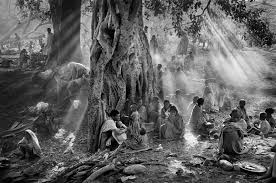Sebastiao Salgado

Today we watched the Wim Wender’s documentary about Brazilian/Magnum photographer Sebastiao Salgado, The Salt of the Earth (2014).

The documentary resonated with me because I have to travelled to some of the places he’d photographed such as the Congo, though I’d been there before the Hutus arrived enmasse in 1994 (I was there in 1990). Kasingani, Goma…towns that I had stayed in that would later be places of slaughter.

While Salgado captures extraordinary shots such as Brazilian gold mine workers, the famines that gripped Ethiopia, the atrocities of the Yugoslavian war or the horrors of the Rwandan slaughter, he is also able to capture the humanity, a topic that became more of a travail of his soul.

Some are reminiscent of Steve McCurry’s work but I would hazard that Salgado got there first.

It was interesting how it was his wife that was the one that was the catalyst for his career after coming home one day with a camera for her studies. Even more surprising that she stuck with him through the years where he disappeared for years at a time.
Damaged by the horror he’d witnessed, he went back to Brazil and on his father’s farm he and wife planted millions of trees, thus recovering the depleted ecosystem. This adventure led him to focus on a new subject Genesis where he focused on the environment.
I really got a lot of this documentary. It really covered not only his life of a social photographer but his own spirit. It gave me a sense of hope about reversing the damage done to the planet.
Brian’s notes:
After you’ve seen the film read this short extract from Susan Sontag’s landmark book, On Photography.
If the film and Salgado intrigues you, it is worth watching an earlier documentary, Spectre of Hope (here on youtube) where he talks with John Berger about his photographs (particularly the work on globalisation and migration). Berger puts forward an interesting and perhaps optimistic viewpoint about why such photos of suffering are important and necessary and how they work.
Photo essay
Having been allocated to work with Taylor, we both set out appropriate subjects for each other. Taylor has a friend whose father runs an antique shop. He restores furniture so I hope to get some interesting shots of him planing a chair, his shoes covered in splots of varnish while he shuffles around the curls of shaved timber legs.
Taylor also has a DJ as an alternative but he was not sure how well that would work out as it wouldn’t be as visually interesting.
For Taylor, I suggested an artist, Hoss Ayes who makes glass and steel sculptures. This would be very visually interesting as he has a big workshop. My second choice was a Nepalese friend who works as a carer but we worried about the issues surrounding consent.
Photo Essay Prac – 7 Images
We looked at various photo essays in class such as ‘How other half live by Jacob Riis (1890), ‘Country Doctor in Life’ Eugene W. Smith and 100photos.time.com.
We looked at how they captured the human condition, that the aim should be to leave the viewer with a particular emotion. Also to consider was narrative structure – beginning, obstacles, conflict, protagonists interacting and resolution.
Other photographers worth investigating are Cindy Sherman, Tracey Moffat, Gregory Crewdson (interwebs), Melanie Pullen. Furthermore, there is a great book to check out: Storytelling with Photographs: How to create a photo essay (book)
With that in mind our group went out and photographed The Exchange. Ours was about friends that bump into each other. One of them has a fatal communicable disease which she passes on to her friend and they both very quickly die within 7 frames. Fun!



